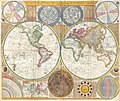Datei:1794 Samuel Dunn Wall Map of the World in Hemispheres - Geographicus - World2-dunn-1794.jpg
Zur Navigation springen
Zur Suche springen

Größe dieser Vorschau: 712 × 600 Pixel. Weitere Auflösungen: 285 × 240 Pixel | 570 × 480 Pixel | 912 × 768 Pixel | 1.216 × 1.024 Pixel | 2.431 × 2.048 Pixel | 6.000 × 5.054 Pixel
Originaldatei (6.000 × 5.054 Pixel, Dateigröße: 8,92 MB, MIME-Typ: image/jpeg)
Dateiversionen
Klicke auf einen Zeitpunkt, um diese Version zu laden.
| Version vom | Vorschaubild | Maße | Benutzer | Kommentar | |
|---|---|---|---|---|---|
| aktuell | 22:01, 1. Jun. 2012 |  | 6.000 × 5.054 (8,92 MB) | Brandmeister~commonswiki | Reverted to version as of 04:17, 23 March 2011 |
| 18:15, 19. Mai 2012 |  | 6.000 × 5.054 (27,38 MB) | Brandmeister~commonswiki | contrast | |
| 06:17, 23. Mär. 2011 |  | 6.000 × 5.054 (8,92 MB) | BotMultichillT | {{subst:User:Multichill/Geographicus |link=http://www.geographicus.com/P/AntiqueMap/World2-dunn-1794 |product_name=1794 Samuel Dunn Wall Map of the World in Hemispheres |map_title=A General Map of the World, or Terraqueouis Globe with all the New Discover |
Dateiverwendung
Die folgenden 2 Seiten verwenden diese Datei:
Globale Dateiverwendung
Die nachfolgenden anderen Wikis verwenden diese Datei:
- Verwendung auf alt.wikipedia.org
- Verwendung auf ar.wikipedia.org
- Verwendung auf av.wikipedia.org
- Verwendung auf br.wiktionary.org
- Verwendung auf ckb.wikipedia.org
- Verwendung auf cv.wikipedia.org
- Verwendung auf en.wikipedia.org
- Early world maps
- History of cartography
- Southern Ocean
- Samuel Dunn (mathematician)
- Wikipedia:Featured picture candidates/1794 Samuel Dunn Map
- A General Map of the World, or Terraqueous Globe
- Wikipedia:Featured picture candidates/June-2012
- User:Cruickshanks/sandbox2
- Wikipedia:Featured picture candidates/March-2014
- Wikipedia:Featured picture candidates/1794 Samuel Dunn Wall Map of the World in Hemispheres - Geographicus - World2-dunn-1794.jpg (review)
- User:Setvina/be bold
- Portal:Maps
- User:Sarangem
- User:Jacobwilder427
- Verwendung auf en.wiktionary.org
- Verwendung auf eo.wikipedia.org
- Verwendung auf et.wikipedia.org
- Verwendung auf eu.wikipedia.org
- Verwendung auf fa.wikipedia.org
- ویکیپدیا:نگارههای برگزیده/نقشه
- ویکیپدیا:گزیدن نگاره برگزیده/ژوئن-۲۰۱۲
- نقشه ساموئل دان
- ویکیپدیا:گزیدن نگاره برگزیده/1794 Samuel Dunn Wall Map of the World in Hemispheres - Geographicus - World2-dunn-1794.jpg
- ویکیپدیا:نگاره روز/اکتبر ۲۰۱۲
- الگو:نر/2012-10-03
- الگو:نر محافظت شده/2012-10-03
- بحث کاربر:Alborzagros/بایگانی ۷
- Verwendung auf fr.wikipedia.org
- Verwendung auf fr.wikiversity.org
- Verwendung auf gl.wikipedia.org
- Verwendung auf hu.wikipedia.org
- Verwendung auf hy.wikipedia.org
- Verwendung auf id.wikipedia.org
- Verwendung auf it.wiktionary.org
Weitere globale Verwendungen dieser Datei anschauen.
